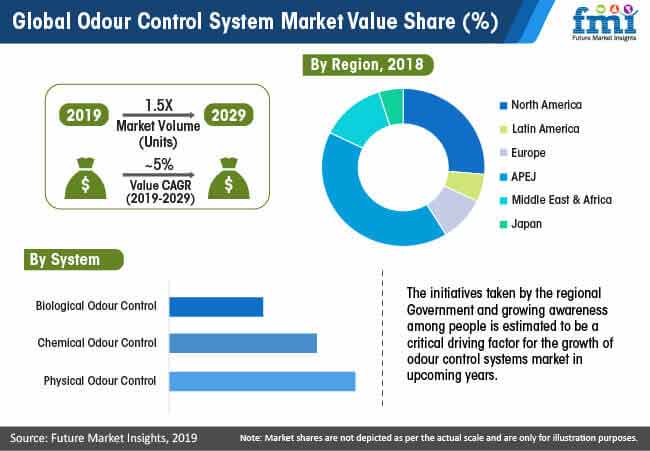
The global standard EN 13725 states that adequate measures need to be taken to minimize the nuisance caused by foul odours. To reduce unwanted variability, air quality is determined by dynamic olfactometry and the procedure should be performed biannually. The measurement is usually compared with the standard data and such regulations have been passed not only in developed economies but also in developing ones. Future Market Insights in its report titled ‘Odour Control System Market: Global Industry Analysis 2012 – 2016 and Opportunity Assessment 2017 – 2027’ has studied the odour control system market for a period of ten years. The odour control system market is anticipated to grow with a robust CAGR of 5.3% for the decade.
System Type – Chemical Odour Control to Lose Share to Biological and Physical Odour Control
The chemical odour control segment had the largest share in the odour control system market in 2012 but is on track to lose its leadership position to the physical odour control segment in 2017. However, the growth of the physical odour control segment pales in comparison to the biological odour control segment with the latter predicted to gain a massive 280 BPS by the end of the forecast period. The biological odour control segment may well witness the highest value CAGR of 6.4% from 2017 to 2027.

Application – Noxious Fumes from Chemical and Petrochemical Segment Require Odour Control Systems
The chemical and petrochemical segment have a market share of over a third in the odour control system market by application segment at the end of 2017 and is likely to remain so for the foreseeable future. The chemical and petrochemical segment is expected to be worth more than half a billion dollars by the end of the decadal study – considerably larger than other segments. Chemical reactions produce odorous compounds such as H2S and NH4 that need to be treated to comply with environmental regulations and avoid corrosion.
Region – APEJ Key Region in Odour Control System Market
APEJ has the maximum share in the odour control system market and could gain 280 BPS at the expense of all other regions barring Japan in the odour control system market. Booming industrial and infrastructural growth in China and India in particular has been significant in the past few years and should sustain for some time to come. Additionally, stringent environmental regulations might be passed in order to control the scourge of air pollution in these nations. The APEJ odour control system market is estimated to record a CAGR of 6.0% for the period.
Request to View Sample Copy of Report @ https://www.futuremarketinsights.com/reports/sample/rep-gb-849
Competition Dashboard in Odour Control System Market
Key stakeholders profiled in odour control system market report are Babcock & Wilcox Enterprises, CECO Environmental., ERG (Air Pollution Control) Ltd, Anguil Environmental Systems, Evoqua Water Technologies LLC, Scotmas Limited, Ecolab Inc., Tholander Ablufttechnik GmbH, Environmental Integrated Solutions, IPEC NV, TANN Corporation, Odour Pro, ECS ENVIRONMENTAL SYSTEMS, Perceptive Industries, Air Technology Systems Ltd., BioAir Solutions, Integrity Municipal Systems, ROMTEC UTILITIES, RPC Technologies Pty Ltd, and COMBINED SEPARATION SYSTEMS PTY LTD.
Request to View TOC @ https://www.futuremarketinsights.com/toc/rep-gb-849
Takeaways
The deployment of odour control systems is largely dependent on factors such as growth in the customer base and regulations that mandate the installation of these systems. The chemical and petrochemical industry segment is the one to look out for as expansion projects and renovations of existing systems is poised to influence market growth. Furthermore, environmental degradation has led to the use of effective waste treatment and recycling strategies. Countries are spending substantial sums on installing and rehabilitating existing systems and companies are also expanding their global presence in the odour control system market.
